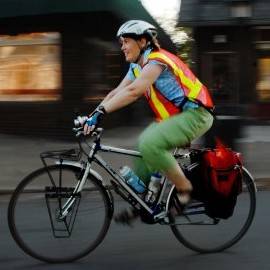 In recent months there has been a lot of discussion about the new bike lanes that have been installed in both Urbana and Champaign. Both cities have plans in place to install more infrastructure for bicycling and walking. Questions have been raised about why the cities would invest in bike lanes instead of focusing on streets for cars. A new report, “Bicycling and Walking in the United States 2010: Benchmarking Report” shows that investing in walking and biking reduces traffic fatalities and chronic disease.
In recent months there has been a lot of discussion about the new bike lanes that have been installed in both Urbana and Champaign. Both cities have plans in place to install more infrastructure for bicycling and walking. Questions have been raised about why the cities would invest in bike lanes instead of focusing on streets for cars. A new report, “Bicycling and Walking in the United States 2010: Benchmarking Report” shows that investing in walking and biking reduces traffic fatalities and chronic disease.
The report reveals that states with the lowest levels of walking and biking have, on average, the highest rates of obesity, diabetes, and high blood pressure. Alternatively, states with the highest rates of walking and biking have, on average, the lowest rates of obesity, diabetes, and high blood pressure. Clearly, having access to infrastructure that provides for walking and/or biking impacts how much physical activity people get. The Centers for Disease Control and Prevention (CDC) recommends that adults get 150 minutes of moderate activity per week and that by doing so you can reduce your risk of dying early from the leading causes of death, like heart disease and some cancers.
The report was prepared by the Alliance for Biking & Walking with input from an impressive list of experts on health and transportation. Jeff Miller, the President of the Alliance, says, “Creating safe streets for everyone will save lives and improve health and quality of life in communities.” Miller further stated, “…our data show that increasing the investment in biking and walking could lead to more people biking and walking. The more people bike and walk, the safer it is and the healthier the community. It’s a virtuous cycle.”
In Champaign-Urbana many people are working hard to help create a healthier and more livable community that includes giving the people the ability to walk and bike to work, school, and shop. Many communities around the country have found that not only is a walkable and bikeable community healthier, it is good for the economy. Places like Madison, Wisc., have found that investing in bicycle lanes and paths that lead to shopping areas, such as their downtown, have seen revitalization as result of these investments. Other place such as Kane County, Ill., invested in the Fox River Trail that resulted in creating vibrant downtowns in places such as Batavia, Geneva, and St. Charles.
Investing in biking and walking is a “win-win” for communities. It not only offers health, safety, and economic benefits, but also reduces congestion on our streets. Why? Because as more people walk and bike it means fewer people are driving and that makes our streets less congested for everyone.
To see the full benchmark report you can go to: http://www.peoplepoweredmovement.org/site/index.php/site/memberservices/C529








